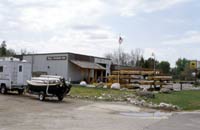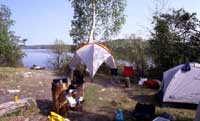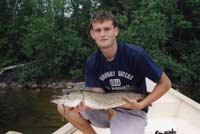Exploring Northern Minnesota’s Basswood Lake
by Dave Nichols
Basswood Lake, in the heart of Northern Minnesota’s Boundary Waters Canoe Area Wilderness, is considered by many people to be one of the areas best lakes. High praise considering the BWCAW is about one million acres of pristine lakes and streams in the middle of the Superior National Forest.
It is about as close to true wilderness as you will find in the United States and the Forest Service keeps it pristine by limiting the size and number of groups that enter the wilderness area. It is also, for the most part, limited to paddle-driven water craft.
Basswood and four other lakes in the BWCA are unique because the Forest Service allows boats with a twenty-five horse power motor or less. But unlike the other lakes, Basswood is not accessible by any road. That means any power boat or canoe going to Basswood must be carried over land. Not much of a problem for canoes and kayaks, but somewhat more challenging for a 400 to 500 pound power boat.
We arrive at Spirit of the Wilderness to pick up permits and get a shuttle to the put in point on Moose Lake
(click images to enlarge)
|
 |
|
There are two basic routes into Basswood Lake-- through Fall Lake and through Moose Lake. If you choose to travel through Fall Lake it means dragging your boat across two portages that are about four or five hundred yards apiece. The boat is centered on a set of wheels and then pulled over the portage. The trail is fairly level but it is still a great deal of work. Fall Lake’s main advantage is entrance permits are easier to acquire. It also gives you access to a different part of Basswood and because of the effort involved you will encounter fewer boats as well.
For my son and me, the best entrance proved to be through Moose Lake’s Prairie Portage. The Prairie Portage is a flatbed trailer pulled by a four-wheel drive truck and has some of the qualities of a theme park ride, only much slower. The trailer is backed into the water and the boat is run up on the trailer. If there are several boats waiting, another boat is run up beside the first and then hauled about a quarter mile to Basswood Lake where the process is reversed.
|
Prairie Portage and the doe |
|
What makes this actually fun is we never got out of the boat. As we bumped along the dirt trail a large doe walked out in front of the truck and slowly disappeared into the forest. Birds, now almost at eye level, flew from tree to tree, as if we weren’t there. It was an unexpected bonus to what we thought would be just the most efficient means to get to Basswood. We paid our haul fee (ten dollars each way) and our feet never touched the ground, as well.
Because the process is so easy, everyone wants to go to Basswood from Moose Lake. This means permits are harder to get and some advanced planning will be needed. Also, the Prairie Portage only operates at certain times of the year and has regular daytime hours so the crossing will have to be planned to match the schedule.
The portage is operated by the LaTourell family and the schedule changes somewhat from year to year. The LaTourell’s have operated a lodge on Moose Lake for many years and are also outfitters for the BWCAW. My son and I have used Spirit of the Wilderness several times as our outfitter and found owner Steve Nelson be a very valuable resource. Steve gets the appropriate permits, has a good selection of gear and food, provides a shuttle service, and allows us to store our truck and trailer while we are in the Boundary Waters. We have also used Piragis Northwoods Outfitters and found them to very helpful as well. There are many outfitters in the area and the Ely Minnesota Chamber of Commerce can provide a list of names. If your own boat exceeds the horsepower limit, most of the outfitters can furnish you with an appropriate boat. All can help you with the permit process and give you the schedule of the Prairie Portage.
Both Harlan, my son, and I were glad we had chosen the Prairie Portage, if for no other reason than the ride. However, when I looked at the amount of gear piled in our boat I was very happy to have the haul to Basswood’s Inlet Bay, the other end of the portage. The young woman driving the truck also provided us with some very useful information.
“Keep your tilt-up unlocked, there’s lots of big rocks where you aren’t expecting them and run slow where you’re unsure,” she said as we cleared the trailer into Inlet Bay. “And watch the wind ‘cause it can get very rough.” That’s sound advice anytime, of course, but very good advice for Basswood Lake.
|
Campsite on Norway Island … first day |
 |
|
After studying the map, Harlan and I decided to make an eight mile run from Inlet Bay to Norway Island. This small island has three campsites on it and sits in the heart of the area we had come to fish. Because the Boundary Waters only allows camping in designated sites we had also picked an alternate island about a quarter mile from our first choice in case Norway’s campsites were occupied.
We prefer island campsites because the bugs don’t seem to be as much of a problem and while the ever-present bears do swim I think there is less chance for an encounter. However, we still bear proofed our campsite and cooked away from our sleeping area.
Norway’s campsite proved to be unoccupied but we were dismayed to find that the previous campers had left a smoldering fire. While the fire danger was not high, it was a thoughtless and potentially harmful act. Had a ranger checked the site and found the fire, the campers would have received a well deserved fine.
|
Harlan nets and releases a nice Northern Pike |
 |
|
It only took about an hour and a half to get our camp set up and we were finished by about four in the afternoon. This gave us some unexpected late afternoon fishing time. So rods were loaded in the boat and we headed across to the main shoreline to search for promising fishing areas and explore. Both Harlan and I enjoy exploring a new area as much as we like fishing. In some cases, the fishing just gives us a reason to go -- not that exploring isn’t reason enough. There is an enormous amount of wildlife to see in the Boundary waters, and each turn or bend usually offers a discovery.
This excursion was no exception and we found ourselves sharing a small stream-fed inlet with a pair of loons. It was perfect, lots of structure underwater as well as along the shoreline. We caught and released several Northern Pike and one Smallmouth Bass before it was time to head back to camp.
|
A Smallmouth Bass caught on conventional tackle |
|
Most, if not all of the lakes in the Boundary Waters, have a mandatory release slot for Northern Pike between 24 and 36 inches. While none of the Pike we caught were in the slot, we still released them. I had planned to have steaks for dinner that night and our meat wouldn’t have kept another day.
While I cooked the steaks, our camp was visited by a completely fearless squirrel. She was picking up some scraps left by the previous campers. While we did enjoy watching her, the scraps didn’t make us very happy. Harlan’s comment, “That’s the kind of thing that brings bears to the campsites,” was correct. The squirrel was joined by a small chipmunk and later by a pair of snowshoe rabbits. The rabbits slowly hopped through the camp as if we weren’t there. Harlan and I were surprised by how close they came to us. I suspect they were much more concerned about the Bald Eagle on the other side of the island than us.
Nighttime proved to be as interesting as the evening. There are no towns to cause light pollution so the number of stars visible is amazing. We watched what had to be the space station sail overhead and listened as loons called to each other in the dark.
|
Our boat, Pescodora, sits on the beach at Norway Island |
 |
|
“It doesn’t get any better than this, Dad.” Harlan was right, of course.
The first day might have been perfect but the next morning proved to be different. We got up to a light breeze that slowly increased as the day progressed. We found plenty of water to fish that was protected from the wind, but by late afternoon the temperature started to drop and the sky suggested we should prepare for some rain. The wind had increased to about 15 to 20 mph with some gusts likely hitting 30 mph. So before starting dinner we shifted things around and tied the tent and canopy down.
Because we had come at the end of May we knew there could be some nasty weather and were prepared with appropriate clothes and gear but about 2 a.m. I was very glad we had used some extra tie downs on all the shelters. The rain was slamming into the tent’s rainfly and lightning was flashing across the sky. It was nice to be able adjust my sleeping bag and drift back to sleep knowing I didn’t need to go outside.
|
A 24 inch Northern Pike caught and released by the author |
|
By morning the rain had stopped and the wind had dropped enough for us to get out and fish. We were able to find plenty of protected water and did quite well. The wind had change and was blowing from the north, so we had to find new areas to fish. Both of us netted and released several nice Pike, two well with-in the slot, and some good Smallmouth Bass. Fishing is generally always good on Basswood and the lake holds the state record for Northern Pike at 45 pounds and 12 ounces. And even though the day’s fishing was good the weather was starting deteriorate again.
|
Harlan's little Pike |
 |
|
Dinner was quiet, and our visitors no longer dropped by. The previous night’s rain had soaked all the firewood so lanterns replaced the campfire. Being able to carry extras like lanterns, small ice chests and comfortable camp chairs are just a few of the many things I like about camping from a power boat. There were no stars but we sat and talked until we were ready to go to bed. We talked about trips in the past and trips to come but the most important thing was we talked. Talking with, and not to, my son is another one of the fringe benefits about camping in power boats that I enjoy.
The wind continued to build during the night so by morning it was blowing hard again, from the north. The sky looked even more threatening and we decided to break camp and head back before it got any worse.
Our run back was mostly on protected water and wasn’t very rough, but the young woman’s caveat proved correct when we got to Bayley Bay. The North wind has almost a three mile run down the gut of the bay so it was rough and the white caps were now on our beam. I had to tack into the swells and then run off to cross the mile or so of open water to the lee of Inlet Bay.
|
A float plane lands as we duck into Inlet Bay |
|
While our boat handled the water just fine it was rougher than I like and in retrospect I should have just sat out the blow on a small island. The wind did drop by late afternoon and we could have crossed the bay easily. Hindsight is always 20/20, but according to Steve Nelson at Sprit of the Wilderness that is the area’s normal weather pattern. It will blow for 24 to 36 hours and then lay, with early morning and late afternoon being the calmest.
I ask Steve if it would have been possible to have taken a radio that would have given us a current forecast, but he said the area is so isolated that even Ely weather doesn’t carry into the Boundary Waters. So unless you carry a satellite phone, the weather forecast has to be done the old fashion way-- by on-site, educated guessing.
The long ride home gave Harlan and me time to discuss what we would change or do differently the next time. I certainly would not cross Bayley Bay again when it is white-capping. Harlan felt we brought too many fly rods. It turns out only one of us can fly fish at a time in our boat. We found one person at the oars keeping the boat in place with the other fishing from the fore deck works best. And I would take a better map of the area. We used fishing maps that are not designed for navigation and these didn’t really take advantage of the GPS. A USGS map would have allowed us to pin point exactly where we were all the time. Both of us agreed that more industrial strength insect repellant should be brought along.
Harlan and I both felt the trip accomplished what we wanted to do. We explored a truly beautiful lake, saw a lot of wildlife, caught enough fish, and spent some quality time together. And for us boating doesn’t get any better than that.

OTHER IMPORTANT INFORMATION

